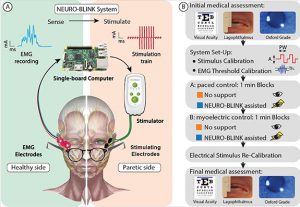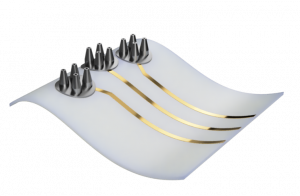INTERNSHIP, SEMESTER AND MASTER PROJECTS
Development of Wearable Bionic System for Eye Electromyography and Blink Neuromodulation
Master thesis
Facial paralysis, caused by conditions like Bell’s palsy or nerve damage, can lead to significant challenges, including the inability to close the eyes, resulting in corneal dryness, discomfort, and potential vision loss. Restoring the blink function through wearable neural interfaces presents a promising non-invasive solution. This project focuses on developing an advanced wearable bionic system using conductive microneedle arrays for high-sensitivity electromyography (eyelid movement monitoring) and precise blink neuromodulation (electrical stimulation of paralyzed eyelids). By penetrating the outermost layer of the skin, microneedle array electrodes enhance recording sensitivity and stimulation selectivity, enabling superior performance compared to existing technologies. Our goal is to develop a closed-loop wearable system that precisely triggers blinking on the paralyzed side of the face in response to the blinking of the healthy eye
Project Objectives:
- Electrode Fabrication: Design electrodes of varying shapes and optimise the fabrication process of conductive microneedle electrodes in the cleanroom
- Device Integration: Integrate the electrodes with a conformable epidermal substrate for real-time electrical recording and stimulation together with a synchronized signal processing software for precise modulation of blinking
- Electromechanical Characterization: Test the mechanical strength, electrical performance, and device robustness in both in-vitro and in-vivo conditions with porcine and human skin.
- Clinical validation: Conduct human trials (in collaboration with Dr. Karla Chaloupka from UZH) to evaluate the system’s safety, usability, and effectiveness in restoring eyelid movement and improving ocular health.

Must-Have Skills:
- Motivation to work on wearable neural interfaces and biomedical systems.
- Basic understanding of biomedical engineering and neural interface principles.
- Ability to work independently and in multidisciplinary teams.
Nice-to-Have Skills:
- Experience working in a cleanroom environment.
- Experience in signal processing and electronic circuits
References
- Mar Cervera-Negueruela et al 2024 J. Neural Eng. 21 026020 (https://iopscience.iop.org/article/10.1088/1741-2552/ad35e7)
- Scherrer, E., Chaloupka, K. 2024 Neurol Sci 45, 1969–1977 (https://doi.org/10.1007/s10072-023-07226-5)
To apply (or for more information): Emilio Fernández Lavado and Horacio Londoño Ramírez
High-Density Electrode Arrays by Hybrid Integration
Master Thesis
This project aims to advance neural interface technology by exploring the hybrid integration of a commercial high-channel recording chip (the Nixel 512 chip from Science Corporation) with the soft, flexible implantable arrays developed at the Laboratory for Soft Bioelectronic Interfaces (LSBI). Utilizing flip-chip bonding, we will integrate a high-performance silicon recording chip with our soft electrode arrays, offering an avenue to increase the density and channel count of our devices.
The project will focus on the fabrication and characterization of implantable electrocorticography (ECoG) arrays incorporating the Nixel chips.
Project Goals:
- Design:
- Design of the layout of the high-density electrode arrays.
- Cleanroom Microfabrication:
- Develop a two-layer metallization process to facilitate the routing in our flexible neural interfaces.
- Fabricate the high-density electrode arrays.
- Optimize the flip-chip bonding of bare dies onto thin-film polymeric substrates, adapted to the selected chip.
- Characterization:
- Characterize electrically and electrochemically the performance of fabricated devices.
- Assess the reliability of the flip-chip bonding process with the selected chip.
Must-have Competencies:
- Strong motivation and interest in the development of novel neural interfaces for biomedical applications.
- Theoretical knowledge of standard microfabrication and photolithography processes.
- Strong understanding of electrophysiology and the basics of bioelectronic interfaces.
- Good problem-solving skills and an ability to work independently within an interdisciplinary team environment.
Nice-to-have Competencies:
- Experience working in a cleanroom environment.
- Experience in bench testing of neural interfaces.
To apply (or for more information): Horacio Londoño Ramírez
Development of Flexible Field Effect Transistor (FET)-Based Sensors for Neural Biosensing Applications
Semester project
This project focuses on the development of flexible Field Effect Transistor (FET)-based sensors designed for biosensing neural signals, including neurotransmitters and other biomarkers such as metabolites or proteins relevant to neural activity. The goal is to enhance neural signal recordings with biochemical insights, offering a better understanding of the neural microenvironment and advancing neuroprosthetics, diagnostics, and bioelectronic medicine.
Project Goals:
- Design and Fabrication:
- Develop flexible FET-based sensors with high sensitivity for neural biomarkers.
- Optimize the fabrication process for reproducibility.
- Surface Functionalization:
- Test the stability and selectivity of functionalized sensors under different conditions.
- Electrical and Biochemical Characterization:
- Evaluate sensor performance parameters such as sensitivity, limit of detection, and response time.
- Application in Neural Biosensing:
- Demonstrate the potential of these sensors to complement neural signal recordings by detecting key neurotransmitters (e.g., dopamine, glutamate) or other biomarkers associated with neural activity.
Must-Have skills:
- Motivation and interest in applying biosensors in neuroscience and other biomedical applications.
- Basic understanding of Field Effect Transistor (FET) principles and biosensor mechanisms.
- Familiarity with neurophysiology, including biomarkers and their significance in neural processes.
- Team-oriented and collaborative mindset.
Nice-to-Have skills:
- Experience with microfabrication techniques and cleanroom processes.
- Knowledge of bioreceptor immobilization strategies (e.g., covalent bonding, adsorption).
- Familiarity with sensor testing in different media (e.g., buffers, biological fluids).
- Understanding of materials science, especially in the context of flexible and biocompatible substrates.
- Knowledge of CAD software and 3D printing for sensor integration and packaging.
References:
Zhao, C., Cheung, K. M., Huang, I.-W., Yang, H., Nakatsuka, N., Liu, W., Cao, Y., Man, T., Weiss, P. S., Monbouquette, H. G., & Andrews, A. M. (2021). Implantable aptamer–field-effect transistor neuroprobes for in vivo neurotransmitter monitoring. Science Advances, 7(48), eabj7422. https://doi.org/10.1126/sciadv.abj7422
To apply, please contact: Desirée Maulá
Development of multifunctional electronic skin based on electrofluidic microneedle arrays
Semester project
This project focuses on the development of an innovative epidermal patch featuring electrofluidic microneedle arrays designed to painlessly penetrate the human epidermis. Our objective is to engineer a multifunctional electronic skin device that delivers electrical signals and injects fluids with high resolution. The device is fabricated leveraging LSBI expertise in microfabrication techniques of soft substrates using advanced, biocompatible materials, incorporating integrated electrical and fluidic systems to enable both precise drug delivery and accurate biosignal monitoring.
This project will consist on the optimization of the fabrication process, taking especially care of the final device assembly and the integration of the cleanroom fabricated components with external flexible PCBs or microfluidic chips. The project will also involve rigorous testing of the device’s electromechanical properties, initially in laboratory settings, followed by animal studies to evaluate biocompatibility and functionality. With successful preliminary outcomes and necessary ethical approvals, we plan to conduct trials on human subjects to test its capabilities in enhancing sensory feedback and physiological monitoring.

Must-have competencies:
- Problem-solving mentality
- Independence and motivation
- Basic concepts of biomedical engineering
Nice-to-have competencies:
- General knowledge in materials science
- Experience in microfluidics and microelectronics
- Cleanroom experience
References:
- Tehrani F., Teymourin H., Wuerstle B. et al.An integrated wearable microneedle array for the continuous monitoring of multiple biomarkers in interstitial fluid. Biomed. Eng (2022). https://doi.org/10.1038/s41551-022-00887-1
- Wang H., Pastorin G., Chengkuo L. et al. Toward Self-Powered Wearable Adhesive Skin Patch with Bendable Microneedle Array for Transdermal Drug Delivery. Advanced Science (2016). https://doi.org/10.1002/advs.201500441
To apply: Emilio Fernandez Lavado
REQUIREMENTS
Students applying for internships must either be awarded credits for their work (e.g. master thesis) or provide their own funding (e.g. non-credited summer internship).
Registered EPFL bachelor and master students
You should organise your agenda to be on site, in Geneva, for at least a full day per week. The travel costs between EPFL Lausanne and EPFL Geneva will be covered.
External students from a partner University
The list of partner universities can be found here. To join the LSBI, you should register first through EPFL academic services – please check the following website for additional information.
External students from a non-partner University
You are welcome to apply to join the LSBI, but you will need to find your own funding source e.g. a scholarship, a grant, etc.
Fellowships
Foreign students are welcome to apply to one of the following schemes to join the LSBI for a summer, a semester or a year-long internship.
EPFL Excellence in Engineering, E3 program for Summer internship